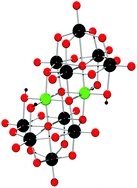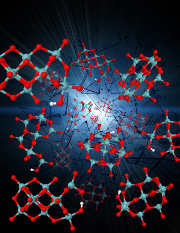Abstract: Recently the authors demonstrated that the decavanadate (V10) ion is a stronger Ca2+-ATPase inhibitor than other
oxometalates, such as the isoelectronic and isostructural decaniobate ion, and the tungstate and molybdate monomer
ions, and that it binds to this protein with a 1:1 stoichiometry. The V10 interaction is not affected by any of the protein
conformations that occur during the process of calcium translocation (i.e. E1, E1P, E2 and E2P) (Fraqueza et al., J.
Inorg. Biochem., 2012). In the present study, the authors further explore this subject, and the authors can now show that
the decaniobate ion, [Nb10 = Nb10O28]6-, is a useful tool in deducing the interaction and the non-competitive Ca2+-
ATPase inhibition by the decavanadate ion [V10 = V10O28]6-. Moreover, decavanadate and vanadate induce protein
cysteine oxidn. whereas no effects were detected for the decaniobate, tungstate or molybdate ions. The presence of the
antioxidant quercetin prevents cysteine oxidn., but not ATPase inhibition, by vanadate or decavanadate. Definitive V(iv)
EPR spectra were obsd. for decavanadate in the presence of sarcoplasmic reticulum Ca2+-ATPase, indicating a
vanadate redn. at some stage of the protein interaction. Raman spectroscopy clearly shows that the protein
conformation changes that are induced by V10, Nb10 and vanadate are different from the ones induced by molybdate and
tungstate monomer ions. Here, Mo and W cause changes similar to those by phosphate, yielding changes similar to the
E1P protein conformation. The putative redn. of vanadium(v) to vanadium(iv) and the non-competitive binding of the V10
and Nb10 decametalates may explain the differences in the Raman spectra compared to those seen in the presence of
molybdate or tungstate. Putting it all together, the authors suggest that the ability of V10 to inhibit the Ca2+-ATPase may
be at least in part due to the process of vanadate redn. and assocd. protein cysteine oxidn. These results contribute to
the understanding and application of these families of mono- and polyoxometalates as effective modulators of many biol.
processes, particularly those assocd. with calcium homeostasis.
Fraqueza, Gil; Batista de Carvalho, Luis A. E.; Marques, M. Paula M.; Maia, Luisa; Ohlin, C. Andre; Casey, William H.; Aureliano, Manuel Decavanadate, decaniobate, tungstate and molybdate interactions with sarcoplasmic reticulum Ca2+-ATPase:
quercetin prevents cysteine oxidation by vanadate but does not reverse ATPase inhibition Dalton Transactions, 2012, 41(41), 12749-12758.



